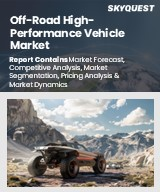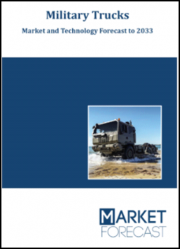
|
시장보고서
상품코드
1616179
탱커 트럭 시장 성장 기회, 성장 촉진요인, 산업 동향 분석 및 예측(2024-2032년)Tanker Truck Market Opportunity, Growth Drivers, Industry Trend Analysis, and Forecast 2024 - 2032 |
||||||
탱커 트럭 세계 시장 규모는 2023년 1,316억 달러로 2024-2032년간 연평균 4.7% 성장할 것으로 예상됩니다.
각 산업 분야의 화학제품 및 연료에 대한 수요 증가가 시장 확대의 주요 요인으로 작용하고 있습니다. 주요 산업 분야는 화학물질과 연료를 포함한 벌크 액체를 안전하고 효율적으로 운송하기 위해 탱크 트럭에 의존하고 있습니다. 전 세계적으로, 특히 신흥 시장에서 산업 활동이 활발해짐에 따라 위험물 및 비위험물 운송을 위한 특수 탱크 트럭의 필요성이 증가하고 있습니다. 또한, 석유화학 생산의 성장과 에너지 수요 증가는 연료 유통 물류에 대한 수요 증가에 기여하고 있으며, 이는 탱크 트럭 시장을 더욱 촉진하고 있습니다.
안전 운송에 대한 엄격한 규제는 첨단 안전 기능을 갖춘 현대적이고 규정을 준수하는 탱크로리에 대한 수요를 증가시키고 있습니다. 도시 인구 증가도 시장 성장의 주요 요인입니다. 특히 개발도상국의 도시화가 진행되면서 물, 연료, 건축자재와 같은 필수 자원에 대한 수요가 증가하고 있으며, 이러한 자원은 모두 탱크로리를 통해 자주 운송되고 있습니다. 도시 인프라의 급속한 확장은 성장하는 도시의 요구 사항을 충족하는 신뢰할 수 있는 운송 서비스의 필요성을 더욱 증가시키고 있습니다.
건설 프로젝트를 위한 대량의 자재 이동, 지방 자치 단체의 물 공급, 연료 수요 등이 이에 해당합니다. 산업 및 도시 개발이 계속 가속화됨에 따라 효율적인 탱크로리 트럭 서비스에 대한 수요도 그에 따라 증가할 것으로 예상됩니다. 용량은 1,000갤런 이하, 1,000-5,000갤런, 5,000-10,000갤런, 10,000갤런 이상 등 4가지로 분류되며, 5,000-10,000갤런 부문이 2023년 33% 이상 시장 점유율로 가장 큰 시장 점유율을 차지할 것으로 예상되며, 2032년에는 675억 달러 이상에 달할 것으로 예상됩니다. 추진력별로 분류하면, 디젤 엔진이 장착된 탱크로리는 2023년 68%의 점유율을 차지하며 계속해서 시장을 지배하고 있습니다. 디젤 엔진은 높은 출력과 연비 효율로 인해 특히 장거리 운송에 선호되고 있습니다. 북미 시장은 2023년 세계 시장의 33% 이상을 차지할 것으로 예상되며, 2032년에는 첨단 인프라와 연료 운송 수요 증가에 힘입어 660억 달러 규모로 성장할 것으로 전망됩니다.
| 시장 범위 | |
|---|---|
| 시작 연도 | 2023년 |
| 예측 연도 | 2024-2032년 |
| 시작 가격 | 1,316억 달러 |
| 예상 가격 | 1,964억 달러 |
| CAGR | 4.7% |
목차
제1장 조사 방법과 조사 범위
제2장 주요 요약
제3장 산업 인사이트
- 생태계 분석
- 공급업체 상황
- 제조업체
- 부품 공급업체
- 탱커 트럭 리스회사
- 운송 및 물류 기업
- 최종사용자
- 이익률 분석
- 각종 탱크 로리 가격 분석
- 기술 및 혁신 전망
- 특허 분석
- 주요 뉴스 및 이니셔티브
- 규제 상황
- 영향요인
- 성장 촉진요인
- 산업의 잠재적 리스크와 과제
- 성장 가능성 분석
- Porter's Five Forces 분석
- PESTEL 분석
제4장 경쟁 구도
- 서론
- 기업 점유율 분석
- 경쟁 포지셔닝 매트릭스
- 전략 전망 매트릭스
제5장 시장 추정·예측 : 용량별, 2021-2032년
- 주요 동향
- 1,000갤런 이하
- 1,000-5,000갤런
- 5,000-10,000갤런
- 10,000갤런 이상
제6장 시장 추정·예측 : 추진력별, 2021-2032년
- 주요 동향
- 디젤
- 전기
- 천연가스
- 하이브리드
제7장 시장 추정·예측 : 재료별, 2021-2032년
- 주요 동향
- 스테인리스
- 알루미늄
- 탄소강
- 복합재료
제8장 시장 추정·예측 : 유형별, 2021-2032년
- 주요 동향
- 단축 탱커
- 다축 탱커
- 연결식 탱커
제9장 시장 추정·예측 : 용도별, 2021-2032년
- 주요 동향
- 석유 및 가스
- 화학제품
- 식품 및 음료
- 물
- 산업용 액체
- 드라이 벌크
제10장 시장 추정·예측 : 지역별, 2021-2032년
- 주요 동향
- 북미
- 미국
- 캐나다
- 유럽
- 영국
- 독일
- 프랑스
- 스페인
- 이탈리아
- 러시아
- 북유럽
- 아시아태평양
- 중국
- 인도
- 일본
- 한국
- 뉴질랜드
- 동남아시아
- 라틴아메리카
- 브라질
- 멕시코
- 아르헨티나
- 중동 및 아프리카
- 아랍에미리트(UAE)
- 남아프리카공화국
- 사우디아라비아
제11장 기업 개요
- DAF Trucks N.V.
- Dongfeng Motor Corporation
- FAW Group Corporation
- Freightliner Trucks
- Hino Motors, Ltd.
- Hyundai Motor Company
- Isuzu Motors Limited
- IVECO S.p.A.
- Mack Trucks
- MAN Truck & Bus AG
- Mercedez(Daimler)
- Mitsubishi Fuso Truck and Bus
- Navistar International Corporation
- Paccar Inc.
- Peterbilt Motors Company
- Scania AB
- Sinotruk(Hong Kong) Limited
- SISU Auto
- Tata Motors
- Volvo Trucks
The Global Tanker Truck Market was valued at USD 131.6 billion in 2023 and is expected to grow at a CAGR of 4.7% between 2024 and 2032. The rising demand for chemicals and fuels across industries is a major factor driving market expansion. Key sectors rely on tanker trucks for the safe and efficient transport of bulk liquids, including chemicals and fuels. As industrial activities increase globally, particularly in emerging markets, the need for specialized tanker trucks to transport hazardous and non-hazardous materials is on the rise. In addition, growth in petrochemical production and the rising energy demand are contributing to an intensified need for fuel distribution logistics, further supporting the tanker truck market.
Strict regulations on safe transportation also boost demand for modern, compliant tanker trucks with advanced safety features. The growing urban population is another major driver of market growth. Increasing urbanization, especially in developing cities, is leading to higher demand for essential resources such as water, fuel, and construction materials, all of which are frequently transported via tanker trucks. The rapid expansion of urban infrastructure further elevates the need for reliable transportation services to meet the requirements of growing cities.
This includes the movement of large quantities of materials for construction projects, municipal water supply, and fuel needs. As industrial and urban development continues to accelerate, the demand for efficient tanker truck services is expected to grow accordingly. In terms of capacity, the market is segmented into four categories: less than 1,000 gallons, 1,000 to 5,000 gallons, 5,000 to 10,000 gallons, and more than 10,000 gallons. The 5,000 to 10,000 gallons segment held the largest market share in 2023, accounting for over 33% and projected to surpass USD 67.5 billion by 2032. This size range offers an ideal balance between load capacity and operational efficiency, making it highly popular across multiple industries.When categorized by propulsion, diesel-powered tanker trucks continue to dominate the market, accounting for 68% of the share in 2023. Diesel engines are favored for their power and fuel efficiency, especially for long-haul transport tasks. The North American market accounted for over 33% of the global share in 2023, with an expected valuation of USD 66 billion by 2032, supported by advanced infrastructure and growing fuel transportation needs.
| Market Scope | |
|---|---|
| Start Year | 2023 |
| Forecast Year | 2024-2032 |
| Start Value | $131.6 Billion |
| Forecast Value | $196.4 Billion |
| CAGR | 4.7% |
Table of Contents
Chapter 1 Methodology & Scope
- 1.1 Research design
- 1.1.1 Research approach
- 1.1.2 Data collection methods
- 1.2 Base estimates and calculations
- 1.2.1 Base year calculation
- 1.2.2 Key trends for market estimates
- 1.3 Forecast model
- 1.4 Primary research & validation
- 1.4.1 Primary sources
- 1.4.2 Data mining sources
- 1.5 Market definitions
Chapter 2 Executive Summary
- 2.1 Industry 360° synopsis, 2021 - 2032
Chapter 3 Industry Insights
- 3.1 Industry ecosystem analysis
- 3.2 Supplier landscape
- 3.2.1 Manufacturers
- 3.2.2 Component suppliers
- 3.2.3 Tanker truck leasing companies
- 3.2.4 Transportation and logistics companies
- 3.2.5 End-users
- 3.3 Profit margin analysis
- 3.4 Price analysis of different tanker trucks
- 3.5 Technology & innovation landscape
- 3.6 Patent analysis
- 3.7 Key news & initiatives
- 3.8 Regulatory landscape
- 3.9 Impact forces
- 3.9.1 Growth drivers
- 3.9.1.1 Increasing demand for chemicals and fuels in various industries
- 3.9.1.2 Industrialization and economic growth across the world
- 3.9.1.3 Advancements in tanker truck technology
- 3.9.1.4 Rising population and urbanization in developing cities
- 3.9.2 Industry pitfalls & challenges
- 3.9.2.1 Rising cost of fuel
- 3.9.2.2 Shortage of qualified drivers
- 3.9.1 Growth drivers
- 3.10 Growth potential analysis
- 3.11 Porter's analysis
- 3.12 PESTEL analysis
Chapter 4 Competitive Landscape, 2023
- 4.1 Introduction
- 4.2 Company market share analysis
- 4.3 Competitive positioning matrix
- 4.4 Strategic outlook matrix
Chapter 5 Market Estimates & Forecast, By Capacity, 2021 - 2032 ($Bn, Units)
- 5.1 Key trends
- 5.2 Less than 1,000 gallons
- 5.3 1,000 to 5,000 gallons
- 5.4 5,000 to 10,000 gallons
- 5.5 More than 10,000 gallons
Chapter 6 Market Estimates & Forecast, By Propulsion, 2021 - 2032 ($Bn, Units)
- 6.1 Key trends
- 6.2 Diesel
- 6.3 Electric
- 6.4 Natural gas
- 6.5 Hybrid
Chapter 7 Market Estimates & Forecast, By Material, 2021 - 2032 ($Bn, Units)
- 7.1 Key trends
- 7.2 Stainless steel
- 7.3 Aluminum
- 7.4 Carbon steel
- 7.5 Composite
Chapter 8 Market Estimates & Forecast, By Type, 2021 - 2032 ($Bn, Units)
- 8.1 Key trends
- 8.2 Single-axle tankers
- 8.3 Multi-axle tankers
- 8.4 Articulated tankers
Chapter 9 Market Estimates & Forecast, By Application, 2021 - 2032 ($Bn, Units)
- 9.1 Key trends
- 9.2 Oil & gas
- 9.3 Chemicals
- 9.4 Food and beverages
- 9.5 Water
- 9.6 Industrial liquids
- 9.7 Dry bulk goods
Chapter 10 Market Estimates & Forecast, By Region, 2021 - 2032 ($Bn, Units)
- 10.1 Key trends
- 10.2 North America
- 10.2.1 U.S.
- 10.2.2 Canada
- 10.3 Europe
- 10.3.1 UK
- 10.3.2 Germany
- 10.3.3 France
- 10.3.4 Spain
- 10.3.5 Italy
- 10.3.6 Russia
- 10.3.7 Nordics
- 10.4 Asia Pacific
- 10.4.1 China
- 10.4.2 India
- 10.4.3 Japan
- 10.4.4 South Korea
- 10.4.5 ANZ
- 10.4.6 Southeast Asia
- 10.5 Latin America
- 10.5.1 Brazil
- 10.5.2 Mexico
- 10.5.3 Argentina
- 10.6 MEA
- 10.6.1 UAE
- 10.6.2 South Africa
- 10.6.3 Saudi Arabia
Chapter 11 Company Profiles
- 11.1 DAF Trucks N.V.
- 11.2 Dongfeng Motor Corporation
- 11.3 FAW Group Corporation
- 11.4 Freightliner Trucks
- 11.5 Hino Motors, Ltd.
- 11.6 Hyundai Motor Company
- 11.7 Isuzu Motors Limited
- 11.8 IVECO S.p.A.
- 11.9 Mack Trucks
- 11.10 MAN Truck & Bus AG
- 11.11 Mercedez (Daimler)
- 11.12 Mitsubishi Fuso Truck and Bus
- 11.13 Navistar International Corporation
- 11.14 Paccar Inc.
- 11.15 Peterbilt Motors Company
- 11.16 Scania AB
- 11.17 Sinotruk (Hong Kong) Limited
- 11.18 SISU Auto
- 11.19 Tata Motors
- 11.20 Volvo Trucks



















